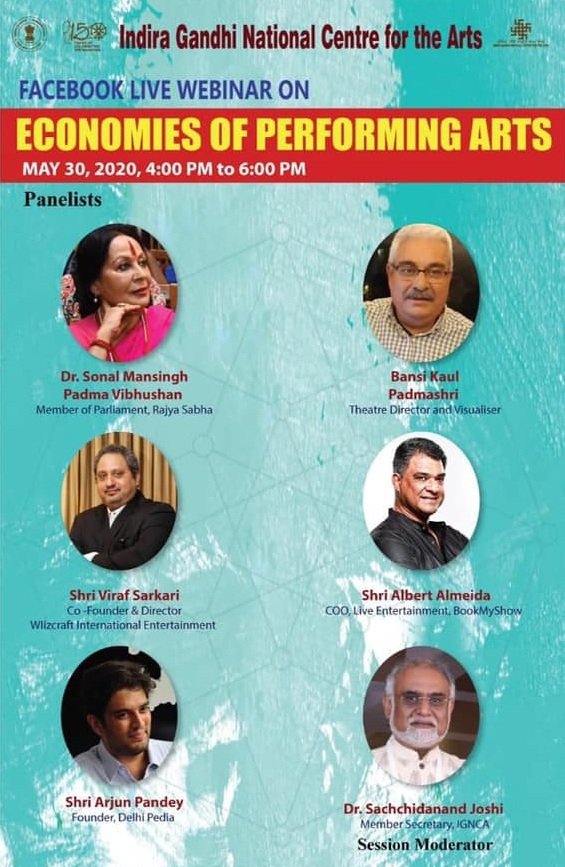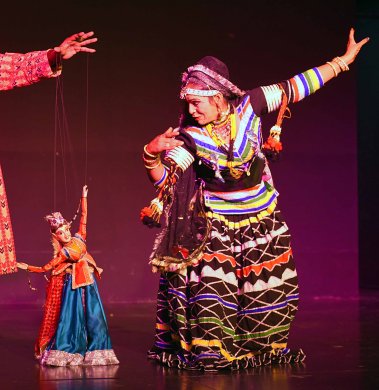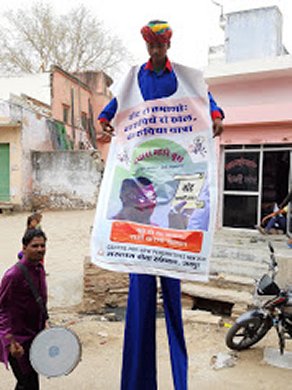
|   |

|   |
 e-mail: leelakaverivenkat@gmail.com At last a discussion on 'Economies of Performing Arts' June 6, 2020 The economic situation of performing artists seems to be a subject which has never engaged the attention of economic planners of present day India. So it was a most pleasantly surprising move to have the IGNCA's Kaladarshan host a Webinar discussion on 'Economies of Performing Arts' - 'to strategize recommendations' for helping this part of our artist population so badly hit by the Covid crisis that some of them face the peril of ceasing to be, unless provided immediate support. The panellists in the discussion were Dr. Sonal Mansingh (member, Rajya Sabha), with Bansi Kaul (Theatre director and visualiser), Viraf Sarkari (co-founder and director, Wizcraft International), Arjun Pandey (founder of Delhi Pedia), and Albert Almeida (COO, Live Entertainment, Book My Show). Dr. Sachchidanand Joshi, Member Secretary, IGNCA, was the moderator.  Sonal Mansingh began with the popular belief of Lakshmi (the Goddess of wealth) and Saraswati (who presided over knowledge and the arts) never being able to co-exist in the same place. The presence of one in abundance, more often than not, means the absence of the other. Our ancient texts like the Ramayana, the Puranas nevertheless, mention 'rajashraya' and 'lokashraya' being together representing the wholeness of human life in every respect. Arts which represent the best of our socio-economic fabric find little mention in the government's schemes like 'MSME', 'Skilled India', 'Make in India' etc. Except for theatre, a more organised sector, it looks as if the performing artiste needs to ascertain, "I perform, therefore I am." "It would seem that like river Saraswati, the performing artistes have disappeared." Broad based planning, professional experience and guidance in online engagements are needed badly in this sector today with all income generating avenues, now rendered out of bounds. Even art connected with agricultural activities, semi-urban performances, not to mention institutions with innumerable students being taught dance - are all closed. Dr. Mansingh mentioned how in an exchange with ex-Finance Minister Arun Jaitley about the need in his fiscal programming to think of the large section of performing artists who did not seem to find any mention anywhere, the Minister mentioned a sum of 1½ crores provided to some artiste Singh recently. The short exchange revealed to her the dire need for planning bodies to be provided with a list of performing artistes prepared by a body like the SNA or IGNCA by persons who understand this sector without putting all performing artistes under one basket. Not given to begging for help, artistes depend on proactive connoisseurship, without being allowed to wither away. "Where is our space?" she asked. Bansi Kaul spoke of the dual role - cultural and social - played by the artistes. He quoted a rough survey of 55000 groups in Young India, of unemployed youth who for a couple of hours every day are engaged in some form of art. Without this, they would perhaps be drug addicts or mental cases. After Sports, the maximum number of self- employed persons is in the world of performing arts, engaged in some activity surrounding art - in the temples, in festival celebrations, in rituals and even marriages and tourism festivals. Artistes have created avenues which while providing support, fetch considerable monetary gains for the government. As an example, Bansi Kaul mentioned the 69 or so Jatra companies inside Odisha providing something like 250 performances a year - bringing in roughly 2000 crores of rupees, employing several people. Similarly, Bengal over the years has had countless repertories. In Assam, such groups employ more than 20000 people and bring in revenue for the State of roughly 26000 crores. The State, he maintained, has a duty towards such people. He quoted as example, the 'Kingdom of Dreams' in Gurgaon, where a large number of people are employed. We need to look at the country holistically - for already we are getting news of suicides and drug abusers. Viraf Sarkari expressed sorrow that 'stress busters' of life which is what artistes are, are being rendered helpless in a clueless world and for him it was sad to see them perform in virtual spaces just to prove their existence, when these spaces do not pay the artistes. This was a kind of emotional exploitation by those presiding over these spaces. Albert Almeida spoke of his 'Book My Show' ventures where they had arranged 2500 shows and 8500 performances per year of digital art. Corporate houses which did help for a time are now themselves looking for sustenance. Digital art should never be free. The time for free shows is over. Arjun Pandey mentioned a 'queue of Padma Shris' and a country with three World Heritage Sites, which should never be allowed to lose out on its cultural identity. He referred to intellectual property rights when the rich film industry copies a Manganiyar tune, with no credits given or compensation for the Manganiyar. "It is time to start treating culture like a product as the Koreans do." If somebody wants to lob into an IGNCA old tape for information, he or she should be made to contribute a small sum, and over a year or a few months a good part of this accumulated sum should go to the persons who have contributed the thoughts or the performance in the video. With over 2 ½ billion videos seen, there should be a protocol. GDP totally ignores arts. Sonal Mansingh rebutted that while names like Manganiyar had become a brand, she herself was not for the hierarchical approach to arts with branding of 'classical,' 'folk' and so on. She felt that performing artistes were doing work even today, which the ignorant people dubbed 'acrobatic', which can be traced to the Karanas which are part of our texts, and lakshanas being used in new ways in work. How could one integrate these ideas with contemporary life was the question. Sonal Mansingh is right and I have seen Odissi artists use the classical grammar in unique ways while doing extremely avant-garde shows for a 'Make in Odisha' or international games events organised in Bhubaneswar. To curate something out of the classical vocabulary for special internet shows is what is needed. Where is the place for the Arts in our Smart Cities, she asked. Sonal felt that intellectual property rights in the field of arts needed more thrust. The artiste was at the bottom of the pyramid, on whose shoulders the arts exist and he or she gets nothing. Doordarshan which will have umpteen screenings of the same programme of dance or music, pays not a sou to the artistes involved. There was mention of the need for cultural zones to be developed round heritage sights to involve and inform people. The example was given of Sanchi Stupa and people in the place being so cut off from its history and culture. Some of this type of work is being done in Odisha where during the Konark Festival, apart from the dance and music, Handloom exhibitions, Literature events, Sand Art Exhibition on the seashore sands etc are put together. But of course, to do this in smaller places without State support is difficult. Almeida also expressed the thought that there were plenty of new ideas which could be used with all groups collaborating. While producing programmes will take time, first a corpus needs to be created to provide help to old artistes, and during times like the present, to bail out the needy marginalized artistes. And here big government funded cultural organisations like the SNA, IGNCA must take the lead. ENCOURAGING EFFORT In this country, we have a body of Street Performers whose lot is particularly pitiable in this Covid situation. Starving due to lack of funds, these daily earners are crying for some sort of reprieve. And away from the IGNCA discussion and elitist organisations, working out ways to help the really needy performers are individuals like Dr. Navina Jafa, Vice-President, TAMA-SHOW, an endeavour which addresses the street performing artistes to reposition and reconnect their skills with different markets. Directed by Pt Birju Maharaj, the launch of this many skilled bonanza with snake charmers, puppeteers, folk dancers, martial art performers, acrobats, and impersonators, with Book My Show chipping in to help created some hope, snuffed out by the lockdown.  'Dilli Ka Bioscope' directed by Pt Birju Maharaj  Acrobat in the Bahurupiya Election Yatra On issues of Elections and Environment, Bahurupiyas, Nats (acrobat) and Folk dancers can produce interesting programmes travelling from one small place to another. They can present short, really educational programmes like "Pollution Hazir Ho." Not willing to give up this effort to save these street performers, TAMA-SHOW has teamed up with Salaam Balak Trust and effort is on to produce three internet shows a week (with nominal payment) for children (whose restlessness in the locked situation is driving some parents crazy) starting on the 12th of June. Navina mentions shows like Bhano the Buffalo, Khil Khil Tota, Popo Steel and pairs like Guru-Chela, Bhabi-Devar - the shows involving folk musicians, puppeteers, Bahurupiyas, magicians and what have you. These efforts call for real encouragement. Let us as a people show that we are ready to help people who live by entertaining us and for no fault of their own are in dire trouble. All muscle to TAMA-SHOW.  Writing on the dance scene for the last forty years, Leela Venkataraman's incisive comments on performances of all dance forms, participation in dance discussions both in India and abroad, and as a regular contributor to Hindu Friday Review, journals like Sruti and Nartanam, makes her voice respected for its balanced critiquing. She is the author of several books like Indian Classical dance: Tradition in Transition, Classical Dance in India and Indian Classical dance: The Renaissance and Beyond. Post your comments Please provide your name and email id when you use the Anonymous profile in the blog to post a comment. All appropriate comments posted with name and email id in the blog will also be featured in the site. |